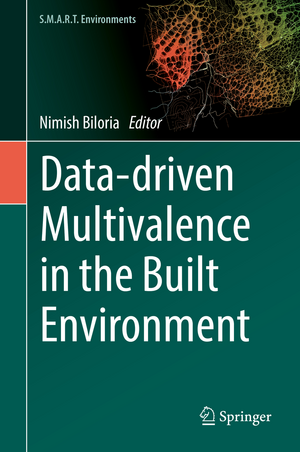Data-driven Multivalence in the Built Environment: S.M.A.R.T. Environments
Editat de Nimish Biloriaen Limba Engleză Hardback – 15 iul 2019
| Toate formatele și edițiile | Preț | Express |
|---|---|---|
| Paperback (1) | 505.25 lei 38-44 zile | |
| Springer International Publishing – 15 aug 2020 | 505.25 lei 38-44 zile | |
| Hardback (1) | 690.95 lei 38-44 zile | |
| Springer International Publishing – 15 iul 2019 | 690.95 lei 38-44 zile |
Preț: 690.95 lei
Preț vechi: 897.34 lei
-23% Nou
Puncte Express: 1036
Preț estimativ în valută:
132.25€ • 143.71$ • 111.17£
132.25€ • 143.71$ • 111.17£
Carte tipărită la comandă
Livrare economică 17-23 aprilie
Preluare comenzi: 021 569.72.76
Specificații
ISBN-13: 9783030121792
ISBN-10: 3030121798
Pagini: 331
Ilustrații: XIV, 338 p. 83 illus., 59 illus. in color.
Dimensiuni: 155 x 235 mm
Ediția:1st ed. 2020
Editura: Springer International Publishing
Colecția Springer
Seria S.M.A.R.T. Environments
Locul publicării:Cham, Switzerland
ISBN-10: 3030121798
Pagini: 331
Ilustrații: XIV, 338 p. 83 illus., 59 illus. in color.
Dimensiuni: 155 x 235 mm
Ediția:1st ed. 2020
Editura: Springer International Publishing
Colecția Springer
Seria S.M.A.R.T. Environments
Locul publicării:Cham, Switzerland
Cuprins
Part 1: PERSPECTIVES ON THE CITY. Chapter1.Smart Equity (Somwrita Sarkar).- Chapter2. The Convenient City(Rob Roggema).- Chapter3. Conceptualization of Smart City: A Methodological Framework for Smart Infrastructure, Smart Solutions and Smart Governance (Aurobindo Ogra).- Part 2:SMART URBAN INFRASTRUCTURE. Chapter4. Development challenges for Big Data Command and Control Centres for Smart Cities in India (Sarbeswar Praharaj).- Chapter5. Understanding consumer demand for new transport technologies and services, and implications for the future of mobility (Akshay Vij).- Chapter6. Smart Interactive Cities: The Use of Computational Tools and Technologies [CTTs] as a Systemic Approach to Reduce Water and Energy Consumption in Urban Areas (Al Saeed Mahmoud and Fadli Fodil).- Part 3: URBAN HEALTH AND WELLBEING. chapter7. Centenarian Transhumanism Aging in Place (Jennifer Loy).- Chapter8. Grey smart societies: Supporting the social inclusion of older adults by smart spatial design (Nienke Moor and Masi Mohammadi).- Chapter9. Real-time interactive multimodal systems for physiological and emotional wellbeing(Nimish Biloria and Dimitra Dritsa).- Part 4: URBAN LIVING LABS.- Chapter10. Design Labs for Data Driven Multivalence(Mathias Funk).- Chapter11. The role of living labs in developing smart cities in Indonesia(Hendra Sandhi Firmansyah).- Part 5: DISRUPTIVE TECHNOLOGIES.- Chapter12. Algae Building: Is This the New Smart Sustainable Technology?( Sara J Wilkinson, Peter J Ralph and Nimish Biloria).- Chapter13. The qualitative image: urban analytics, hybridity and digital representation(Linda Mathews).- Part 6: SOCIO-SPATIAL ECOSYSTEMS.- Chapter14. Multimodal Accommodations for the Nomadic International citizen [MANIC}(Kas Oosterhuis).- Chapter15. Understanding the relationship between smart cities and entrepreneurial ecosystems: the case of Sydney(Cetindamar, D., Lammers, T. and Sick, N.).- Chapter16. Urban Wellbeing in the Contemporary City(Nimish Biloria, Prasuna Reddy, Yuti Ariani and Dhrumil Mehta).- Part7: CONCLUSIONS.
Notă biografică
Dr. Nimish Biloria is an Associate Professor at the, Faculty of Design Architecture and Building at the University of Technology Sydney, Australia. Prior to this, he served as an Assistant Professor at the Faculty of Architecture and the Built Environment, Delft University of Technology, The Netherlands. He has over 15 yrs of experience in the Emergent Technologies and Creative Industry sectors across Europe and Asia and is currently leveraging his global network and expertise within the Australian context. Dr. Biloria’s also serves as the Course Director (Smart cities) at the Faculty of Design Architecture and Building, University of Technology Sydney and was also the Education Manager for the Architectural Engineering and Technology chair Hyperbody, Delft University of Technology, The Netherlands. He has designed and implemented various inter-disciplinary education and research agendas in the areas of Smart Cities & Urban Informatics, Computational Design, Urban Health and Wellbeing, Social Robotics, and Real-time Interactive Environments. Dr. Biloria firmly believes in the strength of inter-disciplinary collaborations to build knowledge synergies and as such has a track record of work across various sectors such as Design, ICT, Human Psychology and Cognition, Healthcare, Humanities, and Robotics to name a few. He has lectured and published his inter-disciplinary research and design deductions at several prestigious and top-ranking institutes, scientific journals, design and technology conferences, scientific books, and magazines globally.
Caracteristici
In-depth coverage of multi-domain data driven design methodologies and architecture frameworks within the built environment Multi-scalar approach covering the micro and macro scales of operation Presents cutting edge research in culturally and economically diverse contexts presented in one comprehensive volume


